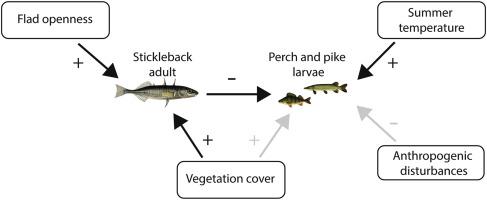Estuarine, Coastal and Shelf Science ( IF 2.8 ) Pub Date : 2020-10-08 , DOI: 10.1016/j.ecss.2020.107052 Serena Donadi , Lena Bergström , Johnny Mats Bertil Berglund , Bäck Anette , Roosa Mikkola , Anniina Saarinen , Ulf Bergström

|
Role reversal can shift fish communities from predator to prey dominance. In the Baltic Sea, the increase in abundance of the small-bodied three-spined stickleback (Gasterosteus aculeatus) has co-occurred with declines of coastal predatory fish, such as perch (Perca fluviatilis) and pike (Esox lucius) in many areas. Recent studies have pointed at predator-prey reversal as a possible mechanism explaining these trends, but conclusive evidence on the phenomenon or its relative importance compared to other drivers is at present open to question. In this study, we applied path analysis to quantify the potential role of stickleback in limiting the recruitment of perch and pike in enclosed bays (i.e. flads) along the Swedish and Finnish coasts. We constructed a causal network model based on vast field data combined with data from GIS and orthophotos, representing fish abundance, hydrographic factors, habitat-forming vegetation, anthropogenic disturbances and geomorphological factors. We found that stickleback abundance had as large effect on larval densities of perch and pike as environmental forcing, represented in our best models by the thermal regime of the flads. Larval densities decreased with stickleback abundance and increased with increasing summer cumulative temperature at a similar rate. Stickleback abundance, in turn, was strongly limited by flad openness, expressed as the number of flad openings to the sea, and increased with vascular plant cover (flad averages). Our study shows that predator-prey reversal could be a strong determinant of perch and pike larval survival, and suggests that the prevalence of more enclosed flads, which are less accessible to stickleback, may be crucial for recruitment of these piscivores. This implies that (1) in areas with, or prone to, increased stickleback abundance, habitat restoration and actions to conserve piscivore populations should primarily focus on more enclosed flads, and that (2) dredging and canalization to enhance boating in these areas could have detrimental effects on piscivore recruitment by decreasing water temperature and enhancing stickleback abundance, hence restricting larval growth and survival.
中文翻译:

棘背捕食和环境强迫限制了沿海海湾鲈鱼和长矛的招募
角色逆转可以将鱼类群落从捕食者转移到猎物主导地位。在波罗的海,小体三刺棘背鱼(Gasterosteus aculeatus)的丰度增加与沿海掠食性鱼类(例如鲈鱼(Perca fluviatilis)和梭子鱼(Esox lucius))在许多地区。最近的研究指出,捕食者-猎物的逆转是解释这些趋势的一种可能机制,但是目前就该现象或其相对于其他驱动因素的相对重要性的确凿证据尚待商question。在这项研究中,我们应用路径分析来量化棘背鱼在限制瑞典和芬兰沿海封闭海湾(即平地)中鲈鱼和长矛的募集中的潜在作用。我们基于广阔的现场数据以及GIS和正射影像的数据构建了因果网络模型,这些模型代表了鱼类的丰度,水文因素,形成栖息地的植被,人为干扰和地貌因素。我们发现,棘背鱼的丰度对鲈鱼和鲈鱼幼体密度的影响与环境强迫一样大,在我们的最佳模型中,襟翼的热状态代表了这一点。幼虫密度随着背stick丰度的降低而降低,并随着夏季累积温度的升高以相似的速率增加。反之,棘背鱼的丰度受到果皮开放度的强烈限制,果皮开放度表示为出海的果皮开口数量,并随着维管植物的覆盖而增加(果皮平均值)。我们的研究表明,捕食者-猎物的逆转可能是鲈鱼和派克幼体存活的重要决定因素,并表明,更多封闭的小鱼的流行对棘背动物来说可能是至关重要的,这些小鱼不易被棘背鱼侵袭。这意味着(1)在棘背丰度增加,生境恢复和保护食肉动物种群的行动上或倾向于增加棘背鱼类种群的地区,应主要着眼于更多封闭的鱼群,

























 京公网安备 11010802027423号
京公网安备 11010802027423号